Carbonates: Aragonite
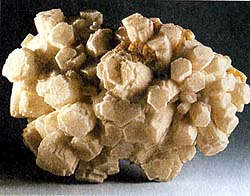 Diagnostic card.
Diagnostic card.
In the photo: aragonite crystals encrusted with white calcite and sulfur (Sicily). Below prismatic aragonite with pyrite.
CaCO 3
Diamond orthogonality
Hardness 3,5-4
Specific weight 2.95
Cleavage is difficult to separate
Cracked shell
Color is colorless, differently colored
Color in powder white
Glitter glass

 Aragonite is calcium carbonate, a solid type of calcite. Forms individual crystals, extremely thin and elongated. Often they are combined into magnificent aggregates of a beam-like or radiant structure. There are also large crystals, twinned in three individuals, with a hexagonal prism formed. Such twins are easy to recognize because they show incoming angles relative to the prism vertices, and most importantly, a shading in three different directions is seen on the plane of their base, each of which corresponds to a separate crystal. Sometimes the mineral takes the form of clusters of the smallest globules (globules), stalactites, fibrous masses and incrustations.
Aragonite is calcium carbonate, a solid type of calcite. Forms individual crystals, extremely thin and elongated. Often they are combined into magnificent aggregates of a beam-like or radiant structure. There are also large crystals, twinned in three individuals, with a hexagonal prism formed. Such twins are easy to recognize because they show incoming angles relative to the prism vertices, and most importantly, a shading in three different directions is seen on the plane of their base, each of which corresponds to a separate crystal. Sometimes the mineral takes the form of clusters of the smallest globules (globules), stalactites, fibrous masses and incrustations.
Aragonite is colorless, translucent and has a glassy sheen. It is quite hard and heavy, differs fragility and well-marked cleavage in the prism, on the planes of which, however, it separates with difficulty. Aragonite has many varieties. Among them, coral aragonite with white ramifications resembling coral. It is also called flos-feri (iron flower), as it was discovered in the iron ore deposit in Styria. In addition, pisolithic aragonite is isolated in the form of spherical concretions, as well as tarnovicite and nicholsonite, containing respectively impurities of lead and zinc.
Chemical composition - content (in%): CaO - 56; СО2 - 44; Admixtures of strontium, magnesium, iron are noted. Singonia - rhombic, rhombo-dipyramidal kind of symmetry.
Aragonite is calcium carbonate, a solid type of calcite. Its color varies from white to light green and violet. The composition of aragonite could include compounds of lead, strontium and zinc. The term "aragonite in the early nineteenth century was introduced by the Saxon geologist A. G. Werner, who formed it from the name of the area in Spain-Aragon, where the aragonite deposit was first discovered.
Aragonites often have a spherical structure. Hence, the alternative names of this mineral, emphasizing this feature of it: "pea", "spiked stone" In geology, spherical or ellipsoidal formations that have a concentrically-laminated or radial-radiant structure are called oolites (Greek oop - "egg" lithos - "stone "). Therefore, spherical aragonites are called "oolitic stones" or simply "oolites". Aragonites, having a bizarre shape of "twigs" or "stems," are called "iron flowers". Aragonite can occur in the form of translucent crystals. This mineral is a part of the shells of shellfish, so aragonite is also figuratively called the "mother of pearls".
Varieties: konhit - the main component (along with chitin) of pearls and pearlescent layer of shells of mollusks; Pea stone - cemented oolites of aragonite. By origin hydrothermal and hypergenic.
 Diagnostic signs.
Diagnostic signs.
Aragonite dissolves in dilute cold acids with vigorous effervescence. This is similar to calcite, but the latter differs in perfect cleavage by the rhombohedron. Some samples of aragonite in ultraviolet rays show luminescence of different colors (blue, pink, yellow). At normal temperature and pressure, the aragonite is rather unstable and tends to convert to calcite, and this phenomenon is accelerated by heating.
Origin.
Less common than calcite, aragonite is found mainly in sediments of low temperatures formed near the surface (caves, oxidation zones of ore deposits, cold springs), as well as in some sedimentary and metamorphic rocks.
Deposits and applications.
Aragonite is found in many places in Italy. In the cracks among serpentine rocks it is found in Konya and Emares (Aosta), in Franca in Val Malenko (province of Sondrio) and in Monte Ramasso near Sestri Panente (province of Genoa). Aragonite is represented by needle individuals in voids among the marbles of the "girioperla" in the Passo della Vorkola (Vicenza province), in the sandstone cavities near Agordo (Belluno province).
In the form of crystalline masses of a fibrous or radiant structure whitish or cyan (the latter is known as mossotte), aragonite is found in Zherfalko (Grosseto province). In the form of crystals, this mineral is found in voids among the lavas of Vesuvius and Etna. The best specimens, including twinned and pseudohexagonal, come from the Roman and Sicilian deposits of sulfur.
Aragonite got its name from the place of discovery - the Aragon region in Spain. Rhombic modification of calcium carbonate. Glitter is glass. Varies from almost transparent to opaque. Colors: gray, yellowish, white, pink, blue; It is colorless. Fracture shell. It's fragile. Cleavage is imperfect. When exposed to cold dilute hydrochloric acid intensively "effervesces", like calcite, and emits bubbles of carbon dioxide. It is formed in hydrothermal ore deposits, cracks, and also in caves.
As a rock-forming mineral is of secondary importance. They are composed, for example, of sedimentary calcareous deposits of warm mineral springs in Karlovy Vary - spudelstein and pea stone. Over time, aragonite always turns into a more stable modification - calcite, so in nature there is no its ancient deposits.
Aragonite is one of the components that make up the shells of shellfish, pearls. Crystals (rhombic syngony) are much less common than calcite. They have the form of prisms with sharp wedge-shaped heads, or they form radial-ray intergrowths of needle crystals, parallel-fiber aggregates, oolites, beautiful branching forms (iron flowers). Twins and tees are common. Places of distribution: Harz (Germany, Germany), Carinthia (Austria), Karlovy Vary (Czech Republic), Italy, Spain.
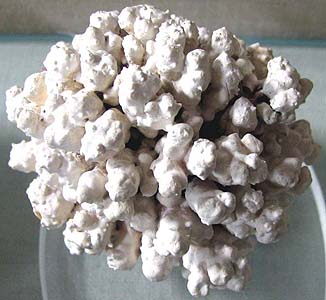

Aragonite. Bata (reefs beyond the city breakwater), Rio Muni, Equ. Guinea. Aragonite. Carinthia, Austria. Photo: © А.А. Evseev.
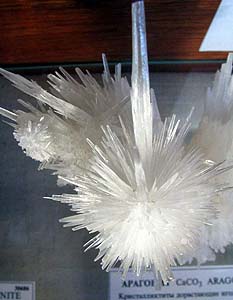
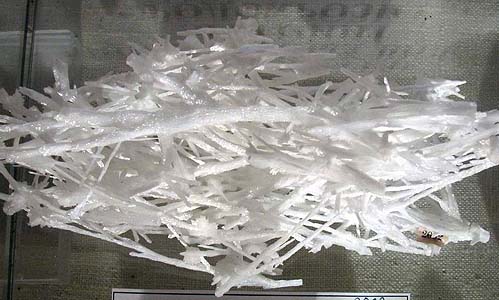
Aragonite. Crystallites. Khaidarkan, Y. Kirghizia. Aragonite. Openwork honeycomb frame made of crystallites. Cave "Gypsum", Khaidarkan, Y. Kirghizia. Photo: © А.А. Evseev.
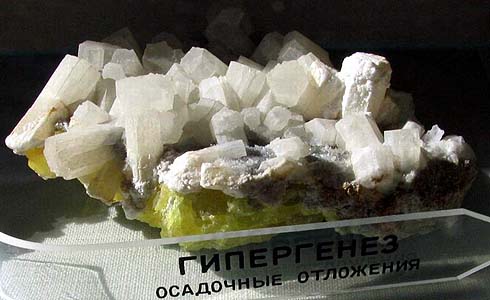
Aragonite. Cianciana \ Cianciana, Sicily, Italy. Photo: © А.А. Evseev.
- Ghetchellit - "New Almaden blend" - arsenide and antimony sulfide (modern sulfosol)
- Antimony is a toxic metal (semimetal) , widely used in metallurgy, medicine and engineering
- Zirconium - a rare and undiscovered metal and the most dangerous precious stone in oxide and salt
- Gold - yellow dangerous and poisonous metal of modern accurate digital and cable technologies
- Sulfur is a golden-yellow toxic substance and a sign of active volcanic activity
- Cadmium is an undisputed toxic silvery metal unknown to a wide range of people
- Lead - a toxic gray imitator of metallic silver and toxic metal blende
- Arsenic is a classic poison of medieval and modern poisoners and medicine in medicine
Poisonous and radioactive dangerous stones and minerals
** - poisonous stones and minerals (mandatory check in the chemical laboratory + explicit indication of toxicity)
** - radioactive stones and minerals (mandatory check on the standard dosimeter + ban on open sales in case of radioactivity exceeding 24 milli / g / h + additional measures of population protection)
Catalog of minerals and semi-precious stones of the world by groups
** - poisonous stones and minerals
** - radioactive stones and minerals


Comments
When commenting on, remember that the content and tone of your message can hurt the feelings of real people, show respect and tolerance to your interlocutors even if you do not share their opinion, your behavior in the conditions of freedom of expression and anonymity provided by the Internet, changes Not only virtual, but also the real world. All comments are hidden from the index, spam is controlled.